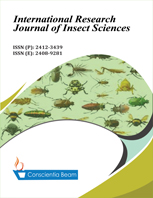Ovitrap Surveillance of the Dengue Vectors Aedes aegypti and Aedes albopictus in Selected Endemic Areas in Sandakan, Sabah
DOI:
https://doi.org/10.18488/journal.106.2021.61.1.7Abstract
Ovitrap technique could be considered an efficient tool for monitoring of Aedes populations. This study aimed to monitor the dengue vector population and to provide baseline data of vector density in selected endemic areas. 1600 ovitraps were placed indoor and outdoor randomly in selected houses from January till July 2014 at eight selected localities. 96%–100% of ovitraps were recovered after seven days. In total, 9399 larvae were examined of which 2674 (28.2%) were Ae. Aegypti and 6752 (71.8%) Ae. albopictus. Ae. albopictus were dominant than Ae. aegypti in every locality. Highest collection of Ae. albopictus was recorded in Kampung Air (total larvae = 1357), followed by Kampung Bokara (total larvae = 1165) and Taman Fajar (total larvae = 846). Three main localities that recorded highest collection of Ae. aegypti were Kampung Bokara (total larvae = 504), Kampung Air (total larvae = 457) and Taman Fajar (total larvae = 341). Ae. albopictus was found more abundant compared to Ae. aegypti. The ovitrap index recorded in all localities (ranged 18.0% - 59.0%) was more than the transmission threshold (10%). Mix breeding of Ae. aegypti and Ae. albopictus were also detected for outdoor ovitraps. In conclusion, this study found that selected localities in Sandakan district have a high risk for transmission and outbreaks of dengue. Furthermore, this study also provided a baseline data of Aedes density for further planning of prevention and control activities.

